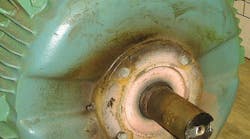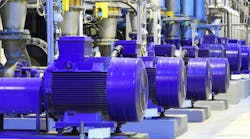Heat is the biggest enemy of the motors we depend on every day. When heat destroys a motor, lost revenue may far exceed the costs of replacement purchase and installation. A ruined batch or stopped assembly line, for example, can delay shipments and cause customers to seek out your competitors. That’s never good for business, and it’s probably not something you want mentioned in your performance appraisal either.
What if you could keep motors from overheating? Sure, you could probably get senior management to spend some serious cash to protect the critical motors, especially if you have tabulated the costs (see Table It). Does that mean the other motors will just have to take their chances? Not at all. With the right multi-pronged strategy, you can cost-effectively reduce heat-induced failures plant-wide, plus eliminate heat-induced failures on critical motors.
Design it out
Select the wrong motor for the application, and you may as well order its replacement at the same time — because you’ll be needing it. You can easily eliminate certain types of motor failures by selecting the:
- Right NEMA design type (B, C, or D) for the torque and usage required. Starting under load? Then get a Type C, not a Type B.
- Appropriate temperature rating for the location. The higher the temperature rating, the better the insulation withstands heat.
- Proper enclosure for the environment. Let’s take the following example as a good case in point. In a pulp mill, a particular motor kept overheating and failing. Because the temperature monitor consistently showed overheating, the plant engineer consistently specified replacements with a ventilated enclosure. However, airborne pulp entered the enclosure and built up on the windings, holding in heat. Specifying a non-ventilated enclosed motor solved the problem.
Give it a good home
Where you put your motor — and how you put it there — affects whether it overheats. So can the power you bring to it.
- Mounting. Provide your motor with a solid base and pedestal. Movement resulting from a flimsy mounting system will translate into motor heat.
- Alignment. Accurate motor alignment reduces vibration and heat in the motor, while reducing stress on whatever is connected to the motor.
- Air. Ensure adequate airflow around the motor, even if this means installing a duct system with forced air flow. If the motor has air intakes, then ensure the filters are easy to change and are on a regular PM for that purpose.
- Power quality. Today’s electronic drives correct power factor and mitigate harmonics, so installing a drive is generally a good power quality move. But the biggest power quality issue is voltage imbalance. The more equal the voltages are on the phases, the better. A difference of 2% or more between any two must be corrected, unless you enjoy buying motors.
Drive it carefully
Electronic drives provide many benefits, but don’t simply add a drive to an existing motor installation as if one spec fits all. You must match the motor to the drive, and both to the application. Doing so isn’t a big mystery — it just takes a methodical, data-driven approach. Your distributor or the drive manufacturer can help you get the benefits you were looking for, without the problems poor selection can bring.
Electronic drives cannot multiply torque, but mechanical gearboxes can. Your application may require combining an electronic drive on the input with a mechanical drive on the output to optimize both motor life and efficiency. A poorly specified motor here is likely to run hot.
Monitor
You should have automatic temperature monitoring on critical motors, if not all motors. Typically, this means installing a resistance temperature device (RTD) or thermocouple and running it back to your process control system or programmable logic controller (PLC). A simple system can alarm on high temperature. A more complex one can monitor the trend and alert you of a trend slope change.
Manual temperature monitoring is also good. You can use it instead of — or complementary to — automatic monitoring. For critical motors, set up a weekly PM for quickly taking heat gun readings. For ventilated motors, check at the vent. For non-ventilated motors, read the enclosure temperature. How can you know if the reading is too high? Get baseline readings before starting this program.
An inexpensive way to detect overheating motors is to use the stick-on temperature dots that change color when heated to a certain temperature. Operators and others nearby, upon noticing, can just notify maintenance. Stick-on graphic thermometers are a variation of this. These cost so little that applying one on every motor is easy to justify.
Don’t overlook thermography. One reason many facilities have a thermography program is the resulting prevention of unplanned shutdowns pays for the program several times over. Even if you’re not a skilled thermographer, you can do a lot of good with a thermal camera, but not as much good as a thermography program can. That requires a skilled thermographer, so outsource to a qualified testing firm — or send someone to classes.
Control
Why do all this monitoring when the motor has thermal overloads? If it might overheat, doesn’t the overload protect it? No, it’s really a current overload device. The overload doesn’t protect against chronic high heat resulting from current that’s not quite high enough to trip the overload, nor does it protect from heat unrelated to current.
There’s another fly in this particular ointment. The idea behind those overloads is some problem causes the motor to draw excess current, so the overload opens, thus preventing overheating. For example, a grinder jams up and the motor’s current demand causes a thermal overload trip. You clear the jam and restart the motor. Do this once, no problem. But maybe you didn’t clear the jam totally. You keep restarting the motor as soon as the overloads let you, and you cook the motor to death.
Critical motors in nuclear power plants have an administratively specified restart waiting time. It doesn’t depend on the cooling of the overload; it depends on the clock. If you compare the thermal mass of the overload to that of the motor, you can understand the thinking here.
According to NEMA, operating a motor just 10°C above its recommended maximum operating temperature cuts its life in half. However, you can destroy a motor in just a couple of hours via repeated restarts — thanks to the difference in thermal mass.
Another problem is that the typical thermal overload is a bimetal strip. Each time it operates, it physically changes — and so does its trip point. If it trips enough times, it ceases to effectively protect the motor from even one overheating (much less rapid sequential restarts).
Electronic motor protection relays do a better job of staying in calibration. Those that employ a means of dynamically adjusting to thermal conditions will accommodate the overeager operator and provide other benefits.
Rather than measure the temperature along the outside of the windings, such a relay can calculate what the temperature will be deep in the windings — so intervention can happen before overheating occurs.
It gets better, though. Today’s relays have additional capabilities that simply aren’t possible with bimetal strips. Instead of burdening your control system with intervention tasks, you can let relays initiate alarms and protective intervention right at the motor — while still keeping the control system fully informed on actions and status.
Although bimetal strips will protect your motor from the high heat resulting from excess current, if restarts are limited, they won’t keep your motor from baking to death under chronic high temperatures that aren’t related to current. Remember, actual temperature isn’t what opens those strips — actual temperature is the problem.
We mentioned air, earlier. What if the ventilation to a motor has been compromised? This was the problem with that pulp mill motor. Any motor with air intakes and filters suffers a similar fate, unless maintenance is scrupulous about monitoring and changing those filters — and typically the staff doesn’t have the time.
Getting the Funding
You must develop a multi-layer monitoring and control approach to protecting motors from heat. Because management more than likely won’t eagerly allocate the funds to buy full protection for every motor, you’ll have to make application-specific decisions on monitoring and control. The other factors we looked at apply to all motors in all applications.
Start with the motors that most damage revenue when they fail, and develop the most rigorous thermal protection scheme for those. Then you can remove functionality from this scheme for other motors, based on how your management perceives the balance of prevention cost against failure cost. This way, you’re not making the case for buying more. Your management is making the case for accepting greater risk to save a few bucks.
SIDEBAR: Table It
Removing a motor and then installing the new one is often a labor-intensive, time-consuming endeavor. Do you have a table showing the total replacement time and lost revenue per hour for each motor in your facility? If not on revenue, on what basis are you determining resource allocation for motor maintenance, and how is that compelling to management?
Lamendola is an electrical consultant based in Merriam, Kan. He can be reached at: [email protected].




